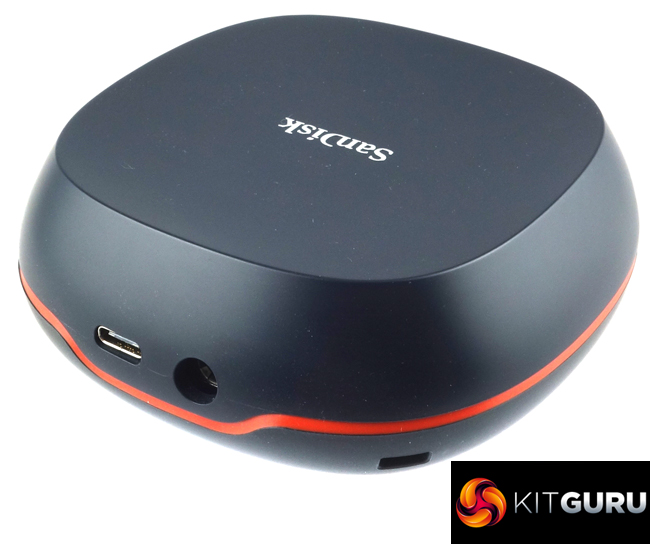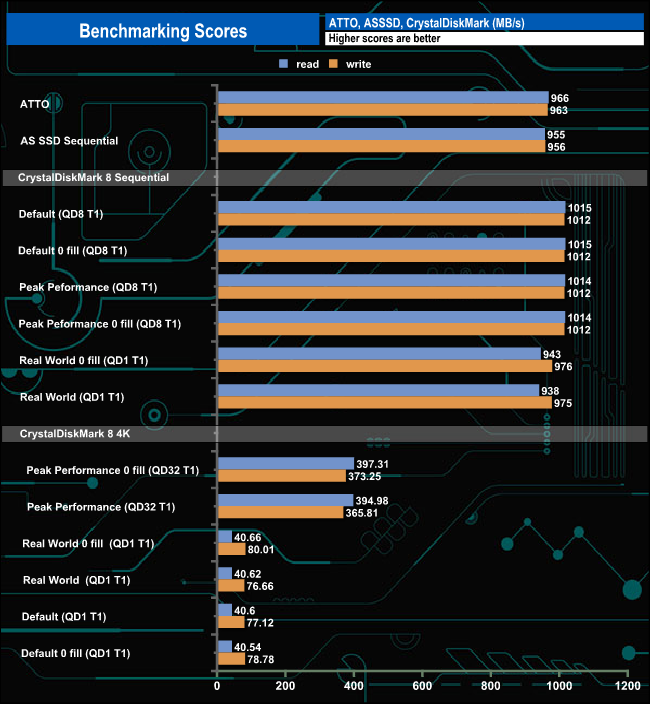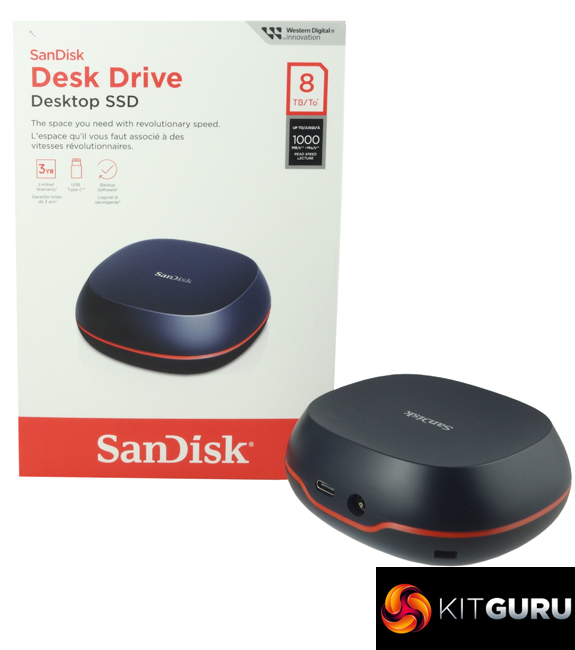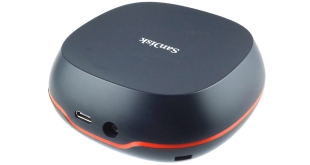
SanDisk's latest drive is the Desk Drive, the company's first desktop SSD, offering large capacity combined with a USB 3.2 Gen 2×1 (10Gbps) interface. We check out the flagship 8TB model, with a price of over £660 here in the UK.
At launch, the SanDisk Desk Drive comes in just two capacities, 4TB and 8TB. SanDisk rates the drive as up to 1,000MB/s for reads but there is nothing listed for write performance.
Although marketed as a drive for the desktop, the SanDisk Desk Drive is compact enough to be carried around (although you will have to remember to carry the power adapter with you as well). The Desk Drive supports both Windows (8.1 and 10 upwards) and MacOS (11 upwards). It supports Apple Time Machine and there is a link bundled with the drive to download Acronis True Image for Western Digital.
SanDisk backs the drive with a 3-year warranty which seems a little mean with 5-year warranties in abundance for SSDs these days.
Physical Specifications:
- Usable Capacities: 8TB.
- NAND Components: BiCS5 112-layer TLC NAND.
- NAND Controller: in-house WD.
- Interface: USB 3.2 Gen 2×1 (10Gbps).
- Form Factor: External.
- Dimensions: 99.2 x 99.2 x 40.2mm,
- Drive Weight: 272g.
Firmware Version: 1007.

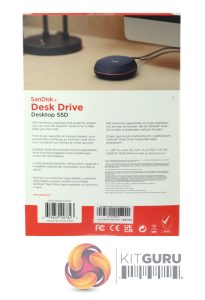
SanDisk's Desk Drive comes in a largish box with a good clear image of the drive itself on the front. Directly above this image and to the left are three icons (with both English and French labels) depicting; a 3-year warranty, the fact the drive uses a USB Type C interface and that it comes with backup software Top right of the box is where you'll find the drive's capacity under which is the read speed, once again both of these are labelled in English and French. The back of the box has some multi-lingual drive information.
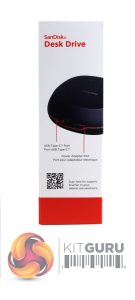
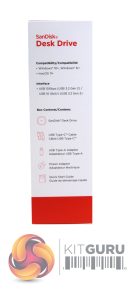
One side of the box shows the drive ports (USB-C and power) in close-up with both English and French labelling. The other side has drive compatibility, interface speed and box contents, again in both English and French.

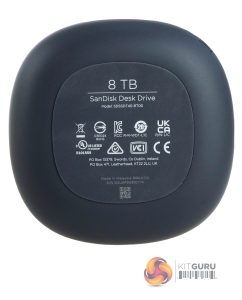
The Disk Drive is of a squared-off circular design measuring 136 x 67 x 202 and weighing in at 272g (not including the power adapter), Finished in black with a thin red plastic centre section, the drive does has a stylish look to it. The base of the drive has a rubber finish to stop it from sliding about when sitting on a desk.
CrystalDiskInfo identifies the drive (or in the case of the 8TB Desk Drive) drives, inside the unit as WD Black SN850X. The Black SN850X is an M.2 2280 PCIe Gen 4 drive that uses a combination of BiCS5 112-layer TLC NAND and an in-house WD controller.
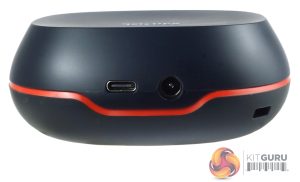
One end of the drive holds the USB-C (the interface is clocked at USB 3.2 Gen2 x 1, 10Gbps) and power adaptor ports and there is also a Kensington Security Slot for added protection when sitting on a desk.

The box bundle is made up of a USB Type-C cable, a USB Type A-C adapter and a power adapter with a choice of socket types. There is a quick start guide in the box.
The SanDisk Disk Drive comes formatted as exFAT so in order to run some of our benchmarks we re-formatted the drive as NTFS.
CrystalDiskMark is a useful benchmark to measure the theoretical performance levels of hard drives and SSDs. We are using V8.
The ATTO Disk Benchmark performance measurement tool is compatible with Microsoft Windows. Measure your storage system performance with various transfer sizes and test lengths for reads and writes. Several options are available to customize your performance measurement including queue depth, overlapped I/O and even a comparison mode with the option to run continuously. Use ATTO Disk Benchmark to test any manufacturer's RAID controllers, storage controllers, host adapters, hard drives and SSD drives and notice that ATTO products will consistently provide the highest level of performance to your storage.
AS SSD is a great free tool designed just for benching Solid State Drives. It performs an array of sequential read-and-write tests, as well as random read-and-write tests with sequential access times over a portion of the drive. AS SSD includes a sub suite of benchmarks with various file pattern algorithms but this is difficult in trying to judge accurate performance figures.
SanDisk quote read transfer speeds of up to 1,000MB/s for the Disk Drive but we couldn't find an official write figure on the spec sheet for the drive. Using the ATTO and AS SSD benchmarks the drive came up a little shy of the official read maximum with test results of 966MB/s and 955MB/s respectively. The best write figure saw for ATTO was 963MB/s while the best AS SSD figure was 956MB/s. Switching over to the CrystalDiskMark 8 benchmark the drive gave up a best-read score of 1,015MB/s (default and 0 fill tests) so confirming the official figure. The best write figure we saw was 1,012MB/s (four out of the six Sequential tests).
The fastest 4K performance came when using the Peak Performance profile (QD32 1 Thread) in CrystalDiskMark 8. The best-read figure we saw from testing the drive was 397.31MB/s with writes at 373.25MB/s. Using the more like real-life Real Word profile we saw a best read / write figures of 40.62MB/s and 80.01MB/s respectively.
SanDisk rates the 8TB Desk Drive at up to 1,000MB/s for Sequential reads. In our throughput tests, the drive didn't quite hit that official maximum with a peak read figure of 932.22MB/s (16MB block). The spec sheet for the drive didn't have any write performance figures but in our throughput test, the drive peaked at the end of the test (16MB block) at 970.54MB/s.
In the read-throughput test, the drive peaked at the 16MB Block, right at the end of the test run at 932.227MB/s. Although some way short of the official maximum of 1,000MB/s, the drive is still one of the fastest we've seen using a USB 3.2 Gen 2 x1 interface.
As with the read test, the write throughput test saw the drive peak at the end of the test with a result of 970.54MB/s. We couldn't find an official write figure for the drive, but that figure of 970.54MB/s puts it among the fastest drives for writes using the interface.
The PCMark 10 Data Drive Benchmark has been designed to test drives that are used for storing files rather than applications. You can also use this test with NAS drives, USB sticks, memory cards, and other external storage devices.
The Data Drive Benchmark uses 3 traces, running 3 passes with each trace:
Trace 1. Copying 339 JPEG files, 2.37 GB in total, in to the target drive (write test).
Trace 2. Making a copy of the JPEG files (read-write test).
Trace 3. Copying the JPEG files to another drive (read test)
Here we show the total bandwidth performance for each of the individual traces.
Trace 1 Write Test compared.
Trace 2 Read-Write Test compared.
Trace 3 Read Test compared.
The 8TB Desk Drive handles the PCMark 10 Data Drive Benchmark well enough. It sits in the top 10 drives for all three parts of the benchmark run (Read-Write, Read and Write traces). It performs best by a very small margin in the Read-Write test. Its overall bandwidth result of 217MB/s sees the drive in sixth place on the results chart.
We also tested the time it took to import and export a mix of files from/to the Disk Drive into various programs.
The programmes we used were:
Microsoft Office (Word, Excel and PowerPoint)
Adobe Acrobat Reader
Adobe Photoshop
VideoPad
Audacity
We also timed moving a Win 10 backup file to and from the drive.

SanDisk's Desk Drive performs well in the load / save tests. It takes just 13 seconds to import a 60MB csv file containing 500,000 records and 9 seconds to export the file to an SSD. A Windows 10 backup (100GB) was copied to the drive in 3 minutes while exporting a 2.6GB 4K video from the app to the drive took 89 seconds.
To test the real-life performance of a drive we use a mix of folder/file types and by using the FastCopy utility (which gives a time as well as MB/s result) we record the performance of drive reading from & writing to a 2TB Seagate FireCuda 510.
Transfer Details:
Windows 10 backup – 118GB.
Data file – 100GB.
BluRay Movie – 42GB.
File folder – 50GB – 28,523 files.
Steam folder – 222GB (8 games: Alien Isolation, Battlefield 4, BioShock Infinite, Crysis 3, Grand Theft Auto V, Shadow Of Mordor, Skyrim, The Witcher3 Wild Hunt).
Movie demos 8K – 21GB – (11 demos).
Raw Movie Clips 4K – 16GB – (9 MP4V files).
Movie folder – 12GB – 15 files – (8 @ .MKV, 4 @ .MOV, 3 @ MP4).
Photo Folder – 10GB – 304 files – (171 @ .RAW, 105 @ JPG, 21 @ .CR2, 5 @ .DNG).
Audio Folder – 10GB – 1,483 files – (1479 @ MP3, 4 @ .FLAC files).
Single large image – 5GB – 1.5bn pixel photo.
3D Printer File Folder – 4.25GB – (166 files – 105 @ .STL, 38 @ .FBX, 11 @ .blend, 5 @ .lwo, 4 @ .OBJ, 3@ .3ds).
AutoCAD File Folder – 1.5GB (80 files – 60 @ .DWG and 20 @.DXF).

In our real-life file transfer tests the 8TB Desk Drive averaged 413MB/s when in write mode for the 13 transfers with the fastest being the 8K movie folder at 944MB/s (24 secs). When it came to the read transfers the drive averaged 989MB/s, the fastest being the 5GB image at 1,017MB/s. When in read mode six out of the thirteen tests topped the 1GB/s mark with all bar one of the remaining tests (the 50GB file folder) topping the 900MB/s mark.
The drive seemed much more efficient at writing the larger file size tests both than the small bity ones. When it came to reads the drive handled all tests in a pretty consistent way.
SanDisk has been in the storage business for over 30 years (they were acquired by Western Digital in 2016) producing a wide range of flash-based products including SSDs, memory cards and readers and USB flash drives. So it comes as somewhat of a surprise that their latest drive, the SanDisk Desk Drive, is their first desktop SSD.
At launch the Desk Drive is available in just two capacities, 4TB and the flagship 8TB drive the company sent in for review. Although designed as a desktop unit, at 136mm x 67mm x 202mm and weighing in at 272g, the drive is compact enough to fit in a large pocket or bag (remembering of course to take the power supply as well!)
The drive uses a USB 3.2 Gen 2×1 interface and SanDisk rates the read performance of the drive as up to 1,000MB/s (we couldn't see the write speed anywhere on the spec sheet for the unit). Using CrystalDiskMark Info, the drive(s) inside the Desk Drive are identified as 4TB WD Black SN850X. The Black SN850X is a PCIe Gen 4 drive rated up to 7,300MB/s and 6,600MB/s for reads and writes respectively using an in-house WD controller and BiCS5 112-layer TLC NAND.
SanDisk rates the read performance of the drive as up to 1,000MB/s. Using the ATTO and ASSSD benchmarks we couldn't quite get to that maximum with test results of 966MB/s and 955MB/s respectively. Switching over to the CrystalDiskMark benchmark we could confirm that official maximum read figure with a best test result of 1,015MB/s (from the default and 0 fill tests QD8 Thread 1). Switching over to the Real World profile the best figure we saw from the drive was 943MB/s (0 fill, QD1 Thread 1). When it came to writes, we didn't have an official maximum but the best we saw from the drive was 1,012MB/s which we got from four of the six CrystalDiskMark Sequential tests.
The 4K performance of the Desk Drive was pretty good. Using the Peak Performance profile (QD32 1 thread) in CrystalDiskMark 8, the best read / write figures we saw were 397.31MB/s and 373.25MB/s respectively. Using the more life-like Real Word profile we saw best read/write figures of 40.62MB/s and 80.01MB/s respectively.
Preloaded on the drive is a link out to a download page to enable you to download Acronis True Image for Western Digital with versions for Mac OS and Windows. The Windows version supports computer backups, setting up of Acronis bootable media, access to security tools and the cloning of internal drives. The Mac version supports backing up of selected disks, folders and files, create Acronis bootable media and file recovery.
We don't yet have a buy link but the MSRP for the 4TB model is £359.99, and the 8TB model will set you back £663.99.
Discuss on our Facebook page HERE.
Pros
- Large capacities.
- Compact design.
- Overall performance.
Cons
- Not bus-powered.
- 3-year warranty is a bit mean.
KitGuru says: It comes as somewhat of a surprise to find that, after being in the storage business for so long, the Desk Drive is SanDisk's first venture in the desktop SSD storage market. It offers large capacities combined with decent performance and it's pretty easy to carry around as well as long as you remember to pack the power supply with it.
 KitGuru KitGuru.net – Tech News | Hardware News | Hardware Reviews | IOS | Mobile | Gaming | Graphics Cards
KitGuru KitGuru.net – Tech News | Hardware News | Hardware Reviews | IOS | Mobile | Gaming | Graphics Cards


